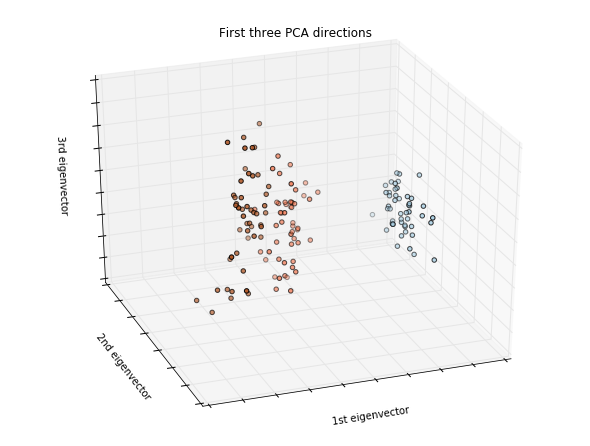机器学习资料集 Datasets - Ex 3: The iris 鸢尾花资料集
优质
小牛编辑
132浏览
2023-12-01
机器学习资料集/ 范例三: The iris dataset
http://scikit-learn.org/stable/auto_examples/datasets/plot_iris_dataset.html
这个范例目的是介绍机器学习范例资料集中的iris 鸢尾花资料集
(一)引入函式库及内建手写数字资料库
#这行是在ipython notebook的介面裏专用,如果在其他介面则可以拿掉%matplotlib inlineimport matplotlib.pyplot as pltfrom mpl_toolkits.mplot3d import Axes3Dfrom sklearn import datasetsfrom sklearn.decomposition import PCA# import some data to play withiris = datasets.load_iris()X = iris.data[:, :2] # we only take the first two features.Y = iris.targetx_min, x_max = X[:, 0].min() - .5, X[:, 0].max() + .5y_min, y_max = X[:, 1].min() - .5, X[:, 1].max() + .5plt.figure(2, figsize=(8, 6))plt.clf()# Plot the training pointsplt.scatter(X[:, 0], X[:, 1], c=Y, cmap=plt.cm.Paired)plt.xlabel('Sepal length')plt.ylabel('Sepal width')plt.xlim(x_min, x_max)plt.ylim(y_min, y_max)plt.xticks(())plt.yticks(())

(二)资料集介绍
iris = datasets.load_iris() 将一个dict型别资料存入iris,我们可以用下面程式码来观察裏面资料
for key,value in iris.items() :try:print (key,value.shape)except:print (key)print(iris['feature_names'])
| 显示 | 说明 |
|---|---|
| (‘target_names’, (3L,)) | 共有三种鸢尾花 setosa, versicolor, virginica |
| (‘data’, (150L, 4L)) | 有150笔资料,共四种特征 |
| (‘target’, (150L,)) | 这150笔资料各是那一种鸢尾花 |
| DESCR | 资料之描述 |
| feature_names | 四个特征代表的意义,分别为 萼片(sepal)之长与宽以及花瓣(petal)之长与宽 |
为了用视觉化方式呈现这个资料集,下面程式码首先使用PCA演算法将资料维度降低至3
X_reduced = PCA(n_components=3).fit_transform(iris.data)
接下来将三个维度的资料立用mpl_toolkits.mplot3d.Axes3D 建立三维绘图空间,并利用 scatter以三个特征资料数值当成座标绘入空间,并以三种iris之数值 Y,来指定资料点的颜色。我们可以看出三种iris中,有一种明显的可以与其他两种区别,而另外两种则无法明显区别。
# To getter a better understanding of interaction of the dimensions# plot the first three PCA dimensionsfig = plt.figure(1, figsize=(8, 6))ax = Axes3D(fig, elev=-150, azim=110)ax.scatter(X_reduced[:, 0], X_reduced[:, 1], X_reduced[:, 2], c=Y,cmap=plt.cm.Paired)ax.set_title("First three PCA directions")ax.set_xlabel("1st eigenvector")ax.w_xaxis.set_ticklabels([])ax.set_ylabel("2nd eigenvector")ax.w_yaxis.set_ticklabels([])ax.set_zlabel("3rd eigenvector")ax.w_zaxis.set_ticklabels([])plt.show()

#接着我们尝试将这个机器学习资料之描述档显示出来print(iris['DESCR'])
Iris Plants DatabaseNotes-----Data Set Characteristics::Number of Instances: 150 (50 in each of three classes):Number of Attributes: 4 numeric, predictive attributes and the class:Attribute Information:- sepal length in cm- sepal width in cm- petal length in cm- petal width in cm- class:- Iris-Setosa- Iris-Versicolour- Iris-Virginica:Summary Statistics:============== ==== ==== ======= ===== ====================Min Max Mean SD Class Correlation============== ==== ==== ======= ===== ====================sepal length: 4.3 7.9 5.84 0.83 0.7826sepal width: 2.0 4.4 3.05 0.43 -0.4194petal length: 1.0 6.9 3.76 1.76 0.9490 (high!)petal width: 0.1 2.5 1.20 0.76 0.9565 (high!)============== ==== ==== ======= ===== ====================:Missing Attribute Values: None:Class Distribution: 33.3% for each of 3 classes.:Creator: R.A. Fisher:Donor: Michael Marshall (MARSHALL%PLU@io.arc.nasa.gov):Date: July, 1988This is a copy of UCI ML iris datasets.http://archive.ics.uci.edu/ml/datasets/IrisThe famous Iris database, first used by Sir R.A FisherThis is perhaps the best known database to be found in thepattern recognition literature. Fisher's paper is a classic in the field andis referenced frequently to this day. (See Duda & Hart, for example.) Thedata set contains 3 classes of 50 instances each, where each class refers to atype of iris plant. One class is linearly separable from the other 2; thelatter are NOT linearly separable from each other.References----------- Fisher,R.A. "The use of multiple measurements in taxonomic problems"Annual Eugenics, 7, Part II, 179-188 (1936); also in "Contributions toMathematical Statistics" (John Wiley, NY, 1950).- Duda,R.O., & Hart,P.E. (1973) Pattern Classification and Scene Analysis.(Q327.D83) John Wiley & Sons. ISBN 0-471-22361-1. See page 218.- Dasarathy, B.V. (1980) "Nosing Around the Neighborhood: A New SystemStructure and Classification Rule for Recognition in Partially ExposedEnvironments". IEEE Transactions on Pattern Analysis and MachineIntelligence, Vol. PAMI-2, No. 1, 67-71.- Gates, G.W. (1972) "The Reduced Nearest Neighbor Rule". IEEE Transactionson Information Theory, May 1972, 431-433.- See also: 1988 MLC Proceedings, 54-64. Cheeseman et al"s AUTOCLASS IIconceptual clustering system finds 3 classes in the data.- Many, many more ...
这个描述档说明了这个资料集是在 1936年时由Fisher建立,为图形识别领域之重要经典范例。共例用四种特征来分类三种鸢尾花
(三)应用范例介绍
在整个scikit-learn应用范例中,有以下几个范例是利用了这组iris资料集。
- 分类法 Classification
- EX 3: Plot classification probability
- 特征选择 Feature Selection
- Ex 5: Test with permutations the significance of a classification score
- Ex 6: Univariate Feature Selection
- 通用范例 General Examples
- Ex 2: Concatenating multiple feature extraction methods

